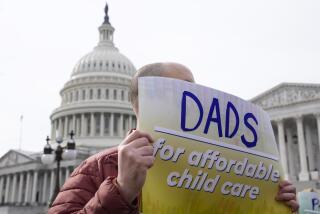It Isn’t the Business of Business
- Share via
In his State of the Union address, President Clinton named three goals for his proposed child-care policy: quality, safety and affordability. While he is to be commended for putting child care on the agenda, prospects for his plan appear mixed.
The president’s ideas for offering scholarships to train providers, instituting background checks and setting up more after-school programs will no doubt raise the quality of child care and make it safer.
But his remedy for affordability doesn’t go far enough. The maximum tax credit of $2,400--available only to a family of four with at least two children in care--will pay for less than a year’s full-time care for one child. Moreover, subsidies in the form of a tax credit don’t address the problem of cash flow, which is considerable in low- and moderate-income families. Parents who are now spending up to one-quarter of their annual income on child care will obviously have to look elsewhere for meaningful assistance.
Equally troubling is the president’s plan to offer incentives to companies to provide child care to employees. This may well undermine whatever good the rest of his approach is able to achieve.
Recent history suggests that, in the area of social policy, incentives to business seldom produce the desired effect. The 1962 public welfare amendments, for example, offered child-care funds to employers who were willing to hire recipients of Aid to Families With Dependent Children; there were few takers. Under the 1981 Economic Recovery Tax Act, companies were allowed to accelerate depreciation for on-site or nearby child-care facilities, but only a handful were willing to undertake the task of construction, much less the headaches of operation.
Tax breaks alone will not motivate employers to provide child care; they must have a specific need for the kind of employees who demand such services. The president’s dismal record of getting companies to create jobs for welfare recipients should serve as fair warning that he is even less likely to get them to set up child-care centers to accommodate this group of workers.
Even if Clinton were to succeed, we should ask ourselves: Do we want American businesses to become one of the chief suppliers of child care? Several problems immediately become apparent.
* What do the manufacturers of widgets know about taking care of children? To be sure, a number of child-care consultants have emerged over the past decade to guide widget-makers into the realm of child care. But without national requirements, there is no guarantee that employers will turn to such services or devote the supervisory personnel and funding necessary to ensure quality.
* Where will the facility be located? Will it be easy to transport children from home to workplace? Will children’s health be jeopardized by fumes, noise or other hazards of manufacturing?
* How does a benefit like child care affect employer-employee relations? What happens if an employee is fired or wants to change jobs? Does her child lose his place in the child-care center? We know that frequent turnover in caretakers is detrimental to child development, and we also know that new entrants into the work force often have difficulty holding onto a job.
* Will on-site centers really be open to all employees? High quality child care is expensive. Unless an employer is willing to provide generous subsidies, there is a good chance that low-wage workers won’t be able to afford it, with or without a tax credit.
The president need look no further than the current health care situation to see the complications that can arise when business takes responsibility for providing a social benefit. As the cost of health insurance rose, employers sought to reduce benefits or find cheaper plans, severely compromising the quality of health care employees could expect. Until coverage was mandated by law, employees with preexisting conditions who moved from one job to another had no guarantee that they would be able to get on the new employer’s insurance plan. And only this month, the White House proposed legislation to provide access to coverage for workers who lose their insurance as well as their jobs through downsizing. One can imagine the same or similar problems arising with employer-supported child-care benefits.
Instead of looking to employers, why not offer incentives to the institutions that are already providing the highest quality child care in our society: community organizations, colleges and universities. Committed not to the bottom line but to the nurturance and development of young children, these voluntary and nonprofit providers have already proved themselves. With funds to expand existing facilities or set up new ones and to subsidize slots for children from low-income families, they could readily accommodate more children. And they would avoid the problems companies are likely to encounter if they venture into the child-care business.
More to Read
Inside the business of entertainment
The Wide Shot brings you news, analysis and insights on everything from streaming wars to production — and what it all means for the future.
You may occasionally receive promotional content from the Los Angeles Times.










